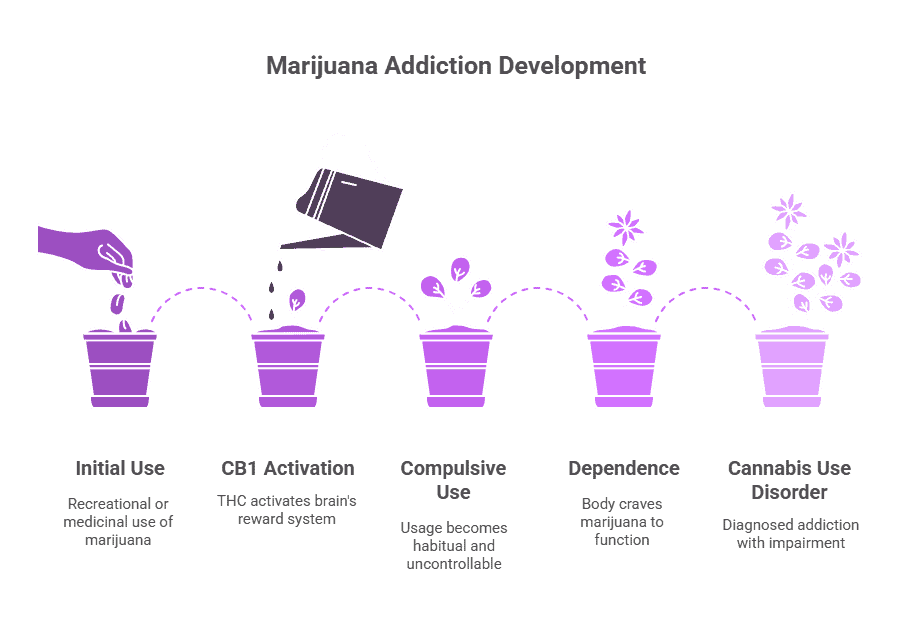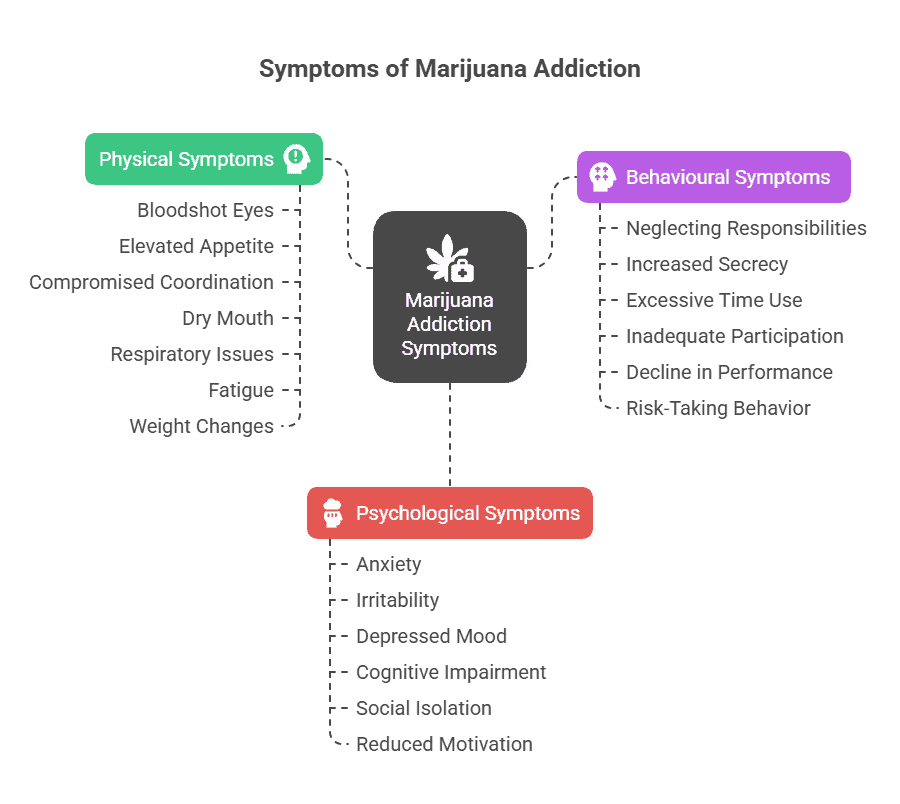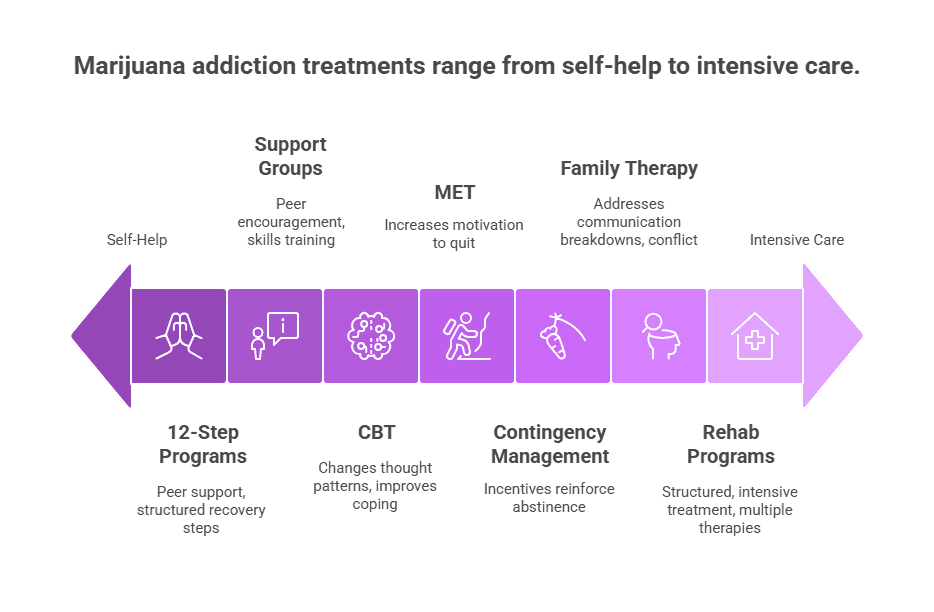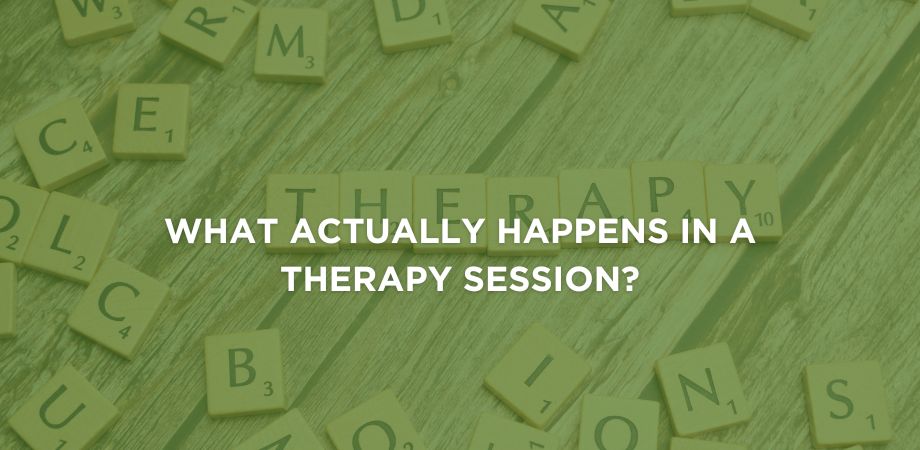Marijuana addiction is characterised by repeated use of cannabis, afflicted by the inability to stop, with a 2019 national survey by the National Institute of Social Defence in India finding that 2.8% of people (3.1 crore) aged 10-75 used cannabis and 0.66% (72 lakh) were dependent, compared to 3% use in 2004.
The primary symptoms of marijuana addiction are physical dependency, behavioural changes like social withdrawal, and psychological symptoms like cravings and mood alterations.
The main causes of marijuana addiction include genetic risk, high THC potency, early and frequent use, and mental health issues.
Withdrawal symptoms involve weakened appetite, sleep disturbances, and mood issues such as anxiety and nervousness.
Treatment of marijuana addiction comprises behavioural therapies such as CBT, de-addiction programs, support groups, and inpatient rehab in severe cases.
Preventing marijuana use is a combination of factors such as early education, mental health awareness, risk factor mitigation, and coping strategies.
What Is Marijuana Addiction?
Marijuana addiction is a psychiatric condition attributed to recursive use of cannabis despite struggling with major impairment or distress. Clinically known as Cannabis Use Disorder (CUD), the disease is recognised under the DSM-5 and ICD-10/11, with severity, mild (2-3 symptoms), moderate (4-5), or severe (6+) classified for the former and listed under code F12 for the latter.
The mechanism of marijuana addiction consists of the activation of CB1 receptors in the brain, which interrupts natural reward systems, reinforcing compulsive usage.
Globally, about 9% of individuals who try marijuana eventually develop dependence, based on DSM-IV (1994) criteria reported by Volkow et al. 2016 in “Adverse Health Effects of Marijuana Use.” A 2013 review by Borgelt et al. in “The Pharmacologic and Clinical Effects of Medical Cannabis” notes that daily use is linked to a 10-20% likelihood of dependence.

What Is Marijuana?
Marijuana, or cannabis, is the dried flowers, leaves, stems, and seeds of the Cannabis sativa plant, containing psychoactive compounds such as tetrahydrocannabinol (THC) and cannabidiol (CBD). THC is the main psychoactive agent that produces the characteristic “high” or euphoria experienced by users.
The world over, people use marijuana for relaxation, euphoria, medicinal purposes, or social connection.
Bhang, made from cannabis leaves and seeds, is excluded from the Narcotic Drugs and Psychotropic Substances (NDPS) Act, 1985, making it generally legal under central law in India, unlike ganja and charas, which remain banned. Its legality, however, varies by state; some prohibit it entirely, like Assam, others regulate or license sales, such as Maharashtra and Gujarat, and certain states allow it mainly during festivals like Holi and Shivratri.
The origins of the word cannabis trace back to a Scythian term and its use in India to at least 2000 BCE, with its earliest mention as “bhang” in the Atharva Veda (2000-1400 BCE), where it was revered as the “Food of the Gods,” “Victory,” and a divine gift. Traditional preparations, charas (resin), ganja (flower), and bhang (leaves and seeds), have long been used, especially during Hindu festivals like Holi and Shivaratri, where consumption is considered auspicious.
What Are the Symptoms of Marijuana Addiction?
The usual symptoms of marijuana addiction are composed of persistent use despite negative consequences, difficulty controlling intake, and the emergence of physical and mental health challenges. The main physical, behavioural, and psychological signs of cannabis dependence are explained below:

Physical Symptoms of Marijuana Addiction
Physical signs of marijuana addiction are bodily changes resulting from prolonged cannabis use, frequently moderate to severe in impact. Familiar examples are:
- Bloodshot eyes
- Elevated appetite (“munchies”)
- Compromised coordination
- Dry mouth
- Respiratory issues from smoking
- Fatigue
- Weight changes
Behavioural Symptoms of Marijuana Addiction
Behavioural signs are noticeable patterns in daily habits and social conduct, of moderate intensity. Routine examples are:
- Neglecting responsibilities
- Increased secrecy about activities
- Spending excessive time obtaining or using cannabis
- Inadequate participation in hobbies
- Decline in academic or work performance
- Risk-taking behavior
Psychological Symptoms of Marijuana Addiction
Psychological signs are mental and emotional disturbances linked to cannabis dependence, trending toward moderate to severe.
Meier et al. 2022 followed 1,037 people born in Dunedin, New Zealand, and found that by age 45, long-term cannabis users had a 5.5-point IQ drop, slower thinking, and memory and learning problems unrelated to other substances or socioeconomic status. They also had smaller hippocampal volumes, suggesting possible lasting cognitive risks, as outlined in “Long-Term Cannabis Use and Cognitive Reserves and Hippocampal Volume in Midlife.”
Standard examples are:
- Anxiety
- Irritability
- Depressed mood
- Cognitive impairment (memory and attention problems)
- Social isolation
- Reduced motivation
What Are the Causes of Marijuana Addiction?
The causes of marijuana addiction are a blend of biological, psychological, and social factors that precipitate cannabis dependence, substance use disorders, and long-term behavioural changes. The primary causes of marijuana addiction are discussed as follows:
- Genetic predisposition: Individuals with a family history of substance use disorders have a higher risk of developing marijuana addiction, with heritability estimates ranging from 30% to 50%, as detailed by Agrawal & Lynskey in “Genetic Epidemiology of Cannabis Use, Abuse, and Dependence.”
- Co-occurring mental health disorders: Conditions like anxiety, depression, and post-traumatic stress disorder accelerate susceptibility to cannabis dependence as individuals use marijuana to self-medicate, which worsens underlying psychological effects over time.
- Frequent and early use: Initiating marijuana use during adolescence is strongly linked to higher rates of cannabis use disorder.
- Consumptive tolerance: Regular consumption evokes tolerance, where higher doses are needed to achieve the same effect, reinforcing behavioural changes that sustain addiction.
What Are the Effects of Marijuana Addiction Withdrawal?
The commonplace effects of marijuana addiction withdrawal are a mix of psychological, physical, and cognitive challenges that disrupt daily functioning. The psychological, physical, and cognitive effects of marijuana addiction withdrawal are indicated below:.
Psychological effects: These effects are intense and hugely influence emotional stability, peaking within the first week of withdrawal. These are:
- Irritability
- Anxiety
- Mood swings
- Restlessness
- Insomnia
- Depressed mood
- Demotivation
Physical effects: These symptoms tend to be mild to moderate but impede comfort and routine activities. These are:
- Nausea
- Headaches
- Sweating
- Chills
- Appetite loss
- Stomach cramps
Cognitive effects: These impairments hinder productivity and concentration, especially during the early stages of abstinence. These are:
- Difficulty concentrating
- Memory lapses
- Slowed thinking
- Reduced mental clarity
- Impaired decision-making
What Are the Treatment Options for Marijuana Addiction?
The treatments for marijuana addiction are a range of evidence-based de-addiction therapies and support systems aimed at curbing cannabis dependence and improving long-term recovery outcomes. The treatment options for marijuana addiction are elaborated below:

Cognitive Behavioural Therapy (CBT)
CBT helps individuals recognise and change thought patterns that trigger marijuana use, improving coping skills and relapse prevention. Effectiveness rates vary from 50-75%, with a large-scale study showing a 62.2% recovery rate after 18 sessions, counter to 44.4% for counselling (Pybis et al., 2017).
Motivational Enhancement Therapy (MET)
MET is a short-term counselling approach that increases motivation to quit by resolving ambivalence.
Contingency Management
This approach uses incentives, such as vouchers or rewards, to reinforce abstinence.
Contingency Management
This approach uses incentives, such as vouchers or rewards, to reinforce abstinence.
12-Step Programs
Peer-led programs like Marijuana Anonymous provide structured recovery steps, social accountability, and emotional support.
Outpatient or Inpatient Rehab Programs
These programs offer structured, intensive treatment ranging from several weeks to months, integrating multiple therapies. Inpatient settings show higher short-term abstinence rates, while outpatient programs support gradual reintegration into daily life.
Family Therapy
What Are the Causes of Gambling Addiction?
Family therapy addresses communication breakdowns, conflict, and enabling behaviours, which are mostly the causative elements that encourage marijuana use.
Support Groups
Non-12-step support groups like SMART Recovery provide peer encouragement and skills training.
How to Prevent Marijuana Addiction
To prevent marijuana addiction, do the following:
- Substance use prevention initiatives: Community-based campaigns and school-led workshops curtail first-time cannabis use.
- Mental health awareness efforts: Promoting access to counselling and emotional support helps lower dependency risks.
- Risk factors screening: Identifying genetic predispositions, trauma history, or environmental triggers early.
- Early intervention programs: Providing targeted assistance to at-risk youth within six months of initial use decreases progression to dependency. A recent study published in The National Medical Journal of India on urban Indian youth found that about 11% were cannabis users, with peer pressure and stress cited as run-of-the-mill reasons for initiation.
- Coping strategies training: Teaching mindfulness, exercise routines, and stress management tools cuts habitual use rates.
- Education programs: Evidence-based school curricula lower marijuana experimentation.
- Peer pressure resistance skills: Role-play and assertiveness training mitigate substance initiation rates.





